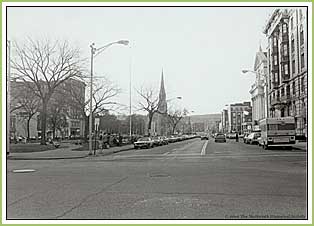
|
 |
 |
 |
 |
At the same time, the town common took on new importance as a permanent oasis of greenery. Often the focal point of an historic neighborhood, the green now serves as much-needed open space in a geography of strip malls and shifting business centers. Yet while town greens throughout the state endure as symbols of hospitality and tradition, these irreplaceable assets are also increasingly endangered by vandalism, traffic, road building, commercial zoning, and the other threats associated with an era of suburban sprawl. |
The town green means pride of place As downtowns increasingly moved or disappeared in the twentieth century, the meetinghouse green diminished in importance as a business center in Connecticut. Its central location, however, contributed to a continuing role as the focus of civic activities ranging from war bond rallies to peace protests.
|
|||||||||||||||||||||||||||||||||||||
Home | GreenLink
| Exhibits | DataCenter
© 2001–2024 TownGreens.com


